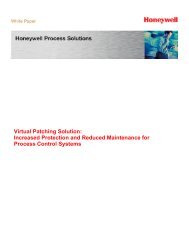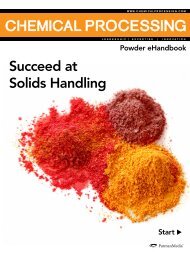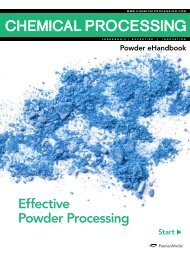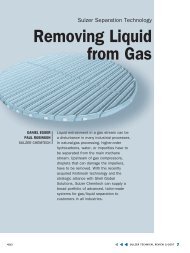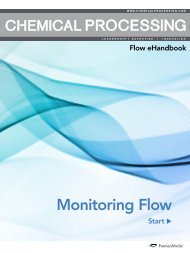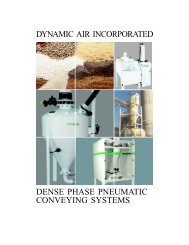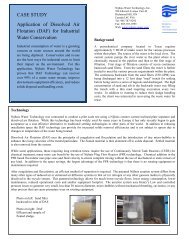Prepare for the Economic Recovery - Chemical Processing
Prepare for the Economic Recovery - Chemical Processing
Prepare for the Economic Recovery - Chemical Processing
Create successful ePaper yourself
Turn your PDF publications into a flip-book with our unique Google optimized e-Paper software.
S P E C I A L R E P O R T<br />
<strong>Prepare</strong> <strong>for</strong> <strong>the</strong> <strong>Economic</strong> <strong>Recovery</strong><br />
Specialty chemicals manufacturers<br />
should take steps now<br />
Brought to you by:<br />
Sponsored by:<br />
Next
Getting ready <strong>for</strong> an economic rebound — or making <strong>the</strong> best of <strong>the</strong> downturn — will<br />
require specialty chemical manufacturers to focus on three primary actions, if <strong>the</strong>y hope<br />
to get or keep a competitive edge, counsels Jamie Bohan, senior segment marketing manager<br />
<strong>for</strong> chemicals and alternative fuels <strong>for</strong> Honeywell Process Solutions, Phoenix.<br />
First, reduce costs while maintaining quality and compliance. This is important as commodity<br />
prices are expected to rise with <strong>the</strong> economic recovery and as global competition<br />
becomes fierce. Second, deliver products to meet commitments, but not so that you cause<br />
yourself or your clients to maintain large inventories. “It’s lean manufacturing, but also lean<br />
supply chain,” she notes. Third, and especially in <strong>the</strong> current market, be able to innovate<br />
quickly — <strong>for</strong> example, when a client wants a new specification such as a higher melting point<br />
ingredient”, she advises. “That’s agile manufacturing, being able to respond quickly and capture<br />
those opportunities. From sales and marketing, to research and development, to quality<br />
assurance, it’s about first mover advantage to capture market share.”<br />
But drill deeper, Bohan says, and you’ll see key focus areas that can lead to achieving <strong>the</strong>se<br />
primary goals: operator efficiency; energy/feedstock management; regulatory and environmental<br />
compliance; and enabling technologies such as scalable plat<strong>for</strong>ms and application foundations.<br />
Optimize operator efficiency<br />
Many companies aim to reduce not only ingredients and suppliers but also workers. However,<br />
loss of veterans depletes intellectual capital, Bohan states. Yet, plant shutdowns and<br />
layoffs typically target employees with higher salaries and that typically means <strong>the</strong> ones<br />
with <strong>the</strong> most experience.<br />
One approach companies may employ to manage this loss of intellectual capital is capturing<br />
knowledge be<strong>for</strong>e shutdowns or layoffs occur. “Then incorporate it into <strong>the</strong> control technologies.<br />
Also have in-place operator training systems, to make it easier <strong>for</strong> new employees,” Bohan says.<br />
Increasing operator efficiency is a way to get <strong>the</strong> most of <strong>the</strong> staff you have and increase productivity<br />
of your operation at <strong>the</strong> same time. There are many ways in which to improve operator<br />
efficiency and wireless use is one of <strong>the</strong>m. For example, instrumentation, such as wireless tank<br />
gauges and pH monitors can replace <strong>the</strong> need <strong>for</strong> operators to collect data from remote locations<br />
multiple times a day, Bohan notes. O<strong>the</strong>rs tools include wireless tablets — laptop computers —<br />
and handheld devices, “so operators can have access to <strong>the</strong> control system from anywhere on <strong>the</strong><br />
site.” This enables fewer skilled operators to carry more responsibility, and still be tied into <strong>the</strong><br />
controls and operations in real-time from anywhere in <strong>the</strong> plant.<br />
Ano<strong>the</strong>r key automation technology is controller based batch execution. This technology can<br />
be used to automate manual procedures and to automate batch processes. Honeywell’s version<br />
is called Experion Batch Manager (EBM). Running batches or procedures in <strong>the</strong> controller can<br />
help manufacturers improve reliability because process controllers can be redundant on most<br />
systems. In Honeywell’s case, EBM also enables drag-and-drop capability so end-users can configure<br />
batch sequences or procedures. “Once configured, <strong>the</strong> operator can automatically see <strong>the</strong><br />
sequence at run time,” Bohan explains. This helps to troubleshoot and keep <strong>the</strong> batch moving.<br />
Improved reliability will become increasingly important as manufacturers try to ramp up capacity<br />
as <strong>the</strong> economy begins to recover.<br />
Economize energy, promote sustainability<br />
Energy, given its cost and what occurs when certain types are used, demands unique consideration,<br />
especially in reducing <strong>the</strong> amount used. It’s a sustainability issue, Bohan notes. The<br />
World Commission on Environment and Development suggests sustainable development<br />
occurs where operations “meet <strong>the</strong> needs of <strong>the</strong> present without compromising <strong>the</strong> ability of<br />
future generations to meet <strong>the</strong>ir own needs.”<br />
How big is this issue? “Most companies have an initiative. But many companies struggle to<br />
get <strong>the</strong>se projects funded, even though you get cost reduction through wise energy use,” Bohan<br />
observes. How companies accomplish energy reduction could be through process changes,<br />
monitoring energy use, optimization software, automating procedures <strong>for</strong> consistency, etc.<br />
She adds, “Companies do try to do cost/benefit analysis, but many are focused on short term<br />
revenue generating projects and not cost saving projects. Energy efficiency projects create op-<br />
PreviouS<br />
Next
portunities to grow revenue by reinvesting<br />
savings into o<strong>the</strong>r projects.”<br />
“We do notice approaches to funding are<br />
different <strong>for</strong> different markets,” Bohan explains.<br />
“If <strong>the</strong> investment is in a growth area — <strong>for</strong><br />
example, specialty chemicals in <strong>the</strong> crop-protection<br />
area has double-digit growth — companies<br />
are more open to trying new technologies with<br />
ei<strong>the</strong>r type of benefit.” But <strong>for</strong> industrial sectors<br />
where growth is flat or worse? “They’re really not<br />
that interested in investing at all right now,” she<br />
observes. “Overwhelmingly, in <strong>the</strong>se markets<br />
we’re hearing customers say <strong>the</strong>y need one year<br />
and even six month ROIs [return on investment],<br />
or it’s a no-go!” Ultimately, manufacturers<br />
have to be able to prove that a sustainability<br />
project, or any project <strong>for</strong> that matter, adds more<br />
revenue to <strong>the</strong> bottom line without impacting<br />
<strong>the</strong> per unit product cost, or <strong>the</strong> project will not<br />
be approved. “That’s where Honeywell can be<br />
of tremendous value to our customers in helping<br />
<strong>the</strong>m to develop and prove <strong>the</strong> project ROI,”<br />
Bohan notes. After all, growth markets require<br />
investment in order to be competitive.<br />
Manage feedstocks<br />
Equally as important as energy management,<br />
feedstock management presents concerns and<br />
opportunities, Bohan suggests. Predictably, cost<br />
associated with feedstocks is a factor. But so<br />
is sustainability and reducing waste, she says.<br />
“Companies want to use as little feedstock as<br />
possible, to keep costs under control, and <strong>the</strong>y<br />
have to be agile enough to adapt to changing<br />
feedstocks as well.” For some specialty<br />
chemical manufacturers, Bohan’s examples<br />
include seeking ingredients that replace<br />
CFCs or volatile organic compounds or come<br />
from renewable sources. Equally important<br />
is automation solutions that ensure <strong>the</strong> right<br />
ingredient is added in <strong>the</strong> right amount to <strong>the</strong><br />
right batch – without any waste.<br />
Ano<strong>the</strong>r feedstock-management challenge<br />
is logistics. “Specialty chemicals can<br />
have hundreds of ingredients. So a question<br />
arises: ‘Can I use a substitute that I already<br />
have, ra<strong>the</strong>r than getting new supply or can I<br />
find a cheaper alternative?’” That’s important,<br />
she believes, because of <strong>the</strong> need to reduce<br />
inventories and suppliers. In this economy it’s<br />
important to have stable, reliable, suppliers<br />
that will last through <strong>the</strong> tough times and<br />
can handle increased demand as <strong>the</strong> economy<br />
recovers. “Material management software<br />
that is highly integrated into <strong>the</strong> automation<br />
system is critical to enable this lean approach<br />
to feedstock challenges,” she notes.<br />
Advance environmental protection<br />
In terms of cost reduction, companies should<br />
start first by identifying <strong>the</strong>ir biggest problem<br />
and <strong>the</strong>n seeing where <strong>the</strong>y can reduce costs.<br />
What’s Honeywell’s role? “It’s helping <strong>the</strong>m<br />
understand <strong>the</strong> biggest opportunities <strong>for</strong> savings,”<br />
Bohan explains.<br />
Certainly environmental compliance<br />
represents a potentially bottom-line-reducing<br />
concern. What’s interesting, Bohan notes, is<br />
that some companies feel <strong>the</strong>y are being <strong>for</strong>ced<br />
to buy software to monitor and report environmental<br />
compliance, <strong>for</strong> example, emissions<br />
of air pollutants, ‘but need to spend money<br />
elsewhere,’ companies say,” she notes.<br />
Occupying inescapable prominence in corporate<br />
boardrooms is manmade global warming,<br />
and what is going to be done about it. There<br />
is also talk about capture and sequestration of<br />
carbon from process and combustion sources.<br />
“‘What should we do now?’ companies ask,”<br />
says Bohan. But, given still-unsettled domestic<br />
and international agreements and regulations,<br />
she observes that what happens “is that people<br />
end up doing nothing and wait <strong>for</strong> legislation to<br />
push <strong>the</strong>m.” Is that <strong>the</strong> right approach?<br />
What Honeywell tries to do is help companies<br />
understand that <strong>the</strong>y can accomplish compliance<br />
“without huge investment - if <strong>the</strong>y have<br />
<strong>the</strong> right underlying plat<strong>for</strong>m,” Bohan notes.<br />
For example, a separate database or historian<br />
or some o<strong>the</strong>r software technology may not be<br />
needed. “You may be able to achieve compliance<br />
with small incremental investments, using existing<br />
automation systems that have <strong>the</strong> flexibility<br />
to adapt as <strong>the</strong> regulatory environment changes.”<br />
Growth through scalability<br />
Plants generally need to increase efficiencies<br />
Plant success story<br />
Through a mix of automation systems, Honeywell<br />
Process Solutions helped a sister company,<br />
Honeywell Specialty Materials (HSM),<br />
increase productivity at its Baton Rouge, La.,<br />
plant, <strong>the</strong> world’s largest hydrofluoric acid<br />
producer. HSM uses automated control systems<br />
along with a comprehensive, integrated<br />
business approach to drive sustained and<br />
exceptional per<strong>for</strong>mance in safety, quality,<br />
delivery, cost and inventory. The system<br />
leverages our Six Sigma Plus foundation,<br />
particularly lean tools and philosophies,”<br />
notes Mike Lawrence, technical leader at <strong>the</strong><br />
plant. “This has been key in maintaining and<br />
improving our competitiveness.”<br />
To optimize plant control, ano<strong>the</strong>r Honeywell<br />
Specialty Materials plant in Geismar, La.<br />
used HPS automation and control technologies:<br />
Experion Process Knowledge System<br />
(PKS) distributed control system, Uni<strong>for</strong>mance/PHD<br />
process historian and Experion<br />
Batch Manager <strong>for</strong> procedural operations.<br />
HSM realized several benefits from<br />
implementing this mix of technologies.<br />
The amount of time <strong>the</strong> plant operated at<br />
lower production rates decreased. Loads<br />
on operators went down, allowing <strong>the</strong>m to<br />
deal with only <strong>the</strong> “important” trigger points<br />
in <strong>the</strong> process. Reactor catalyst efficiency<br />
increased because regeneration variability<br />
fell, giving longer and more stable catalyst<br />
life. And <strong>the</strong> sequence control module in<br />
Experion facilitated easier programming<br />
and offline testing be<strong>for</strong>e <strong>the</strong> system went<br />
online. “We took a complicated offline procedure<br />
that was running on a periodic basis<br />
and automated <strong>the</strong> entire process removing<br />
a lot of <strong>the</strong> guesswork and manual intervention<br />
that was previously required,” states Jim<br />
Hull, plant manager.<br />
everywhere, not just with operators. Scalable<br />
plat<strong>for</strong>ms can provide this. “In specialty<br />
chemicals, small plants may be manual, especially<br />
in certain regions,” Bohan observes.<br />
But when quality becomes more of a factor,<br />
<strong>the</strong>ir owners may want to move to automation;<br />
<strong>for</strong> example, starting with simple graphics<br />
and input/output (I/O) sequencing. The<br />
progression of those I/O could be from 30 to<br />
300 to several thousand over time, she says.<br />
But consider <strong>the</strong> one-step-at-a-time approach.<br />
“Start small and invest as it makes<br />
sense. There’s no need to overspend initially,<br />
especially in this current economy,” Bohan<br />
advises. The key value, she thinks, with such<br />
staged investment is plat<strong>for</strong>ms that enable<br />
companies to retain initial investments in<br />
databases, graphics and logic.<br />
None<strong>the</strong>less, some automation remains<br />
must-have versus nice-to-have. Must-haves include<br />
“anything safety related, anything heatrelated,”<br />
Bohan notes. End-users can also look<br />
at automated ingredient addition. “Though<br />
PreviouS<br />
Next
lots of people do this manually, you can cut<br />
back on <strong>the</strong> time to do ingredient additions,<br />
improve quality and reduce waste through<br />
automation.” Complex pieces of equipment are<br />
candidates <strong>for</strong> automation, too.<br />
Ano<strong>the</strong>r logical automation candidate is<br />
recordkeeping and quality management. “As<br />
<strong>the</strong> number of recipes becomes larger, it becomes<br />
harder to manage what you put in and<br />
what you get out,” Bohan observes. This may<br />
be particularly true when going from simpler<br />
processes to more complex ones, “when it<br />
may be more difficult to understand what<br />
impacts quality.”<br />
Scalable plat<strong>for</strong>ms also offer <strong>the</strong> ability<br />
to assimilate new applications. “This goes to<br />
competitiveness and agility,” Bohan stresses.<br />
And competitiveness evolves from going from<br />
manual to automated operations to <strong>the</strong> point<br />
where “you need to manufacture product, reliably,<br />
with <strong>the</strong> lowest cost — and you have to<br />
optimize your supply chain.”<br />
Automation as <strong>the</strong> enabler<br />
A key factor <strong>for</strong> companies to have in place<br />
to emerge successfully from <strong>the</strong> economic<br />
downturn; addressing all <strong>the</strong> critical factors<br />
mentioned here — is automation. In order<br />
to increase productivity and operator efficiency,<br />
improve agility, increase sustainability,<br />
and reduce costs, automation technology<br />
can be a competitive imperative. As Bohan<br />
observes, “most companies have some level<br />
of automation. And <strong>the</strong> successful ones have<br />
an automation master plan.” Many companies<br />
do planning — but what <strong>the</strong>y fail to do<br />
is to talk with people in <strong>the</strong>ir company who<br />
are in R&D, supply chain, marketing and<br />
sales.” These folks are keyed in to <strong>the</strong> company’s<br />
future growth plans and can help <strong>the</strong><br />
control and automation teams understand<br />
what’s in <strong>the</strong> pipeline and to incorporate<br />
<strong>the</strong>se goals into an automation and control<br />
strategy. “You certainly don’t want <strong>the</strong><br />
automation system to be on <strong>the</strong> critical path<br />
<strong>for</strong> a new growth initiative,” she notes, “you<br />
want to stay ahead of that curve.”<br />
Defining automation needs upfront using<br />
an automation master plan can help companies<br />
to quickly enact solutions, Bohan says. In her<br />
experience, she’s noticed top-tier per<strong>for</strong>mers<br />
have such plans in place. That suggests <strong>the</strong>re’s<br />
competitive advantage to having automated<br />
controls. “Automation is viewed as a competitive<br />
advantage by <strong>the</strong> market leaders,” she declares.<br />
For specialty chemical manufacturers, hav-<br />
ing automated plants may mean <strong>the</strong> difference<br />
between meeting quality targets or not; shipping<br />
orders on time; or just keeping up with<br />
<strong>the</strong> market, Bohan suggests. “For example,<br />
with specialty chemicals, how quickly can you<br />
integrate a new feedstock?” Without automation,<br />
keeping track of it manually, with <strong>the</strong><br />
pace of today’s business “is nearly impossible.”<br />
Not every specialty chemical company will<br />
emerge from this economic downturn successfully<br />
— it’s important to do everything you<br />
can now, to lay <strong>the</strong> groundwork <strong>for</strong> success as<br />
demand starts to ramp-up.<br />
Understandably, cost restrictions concern<br />
many in specialty chemicals, Bohan emphasizes.<br />
That concern will drive end-users to<br />
CLICK HERE<br />
“justify <strong>the</strong>se automation solutions — <strong>for</strong><br />
example, sensors and instrumentation,<br />
programmable logic controllers, human/machine<br />
interfaces, data historians, production<br />
scheduling, batch management, etc. — on<br />
a cost/benefit analysis.” Then, when <strong>the</strong> market<br />
ramps up, producers have <strong>the</strong> enablers in<br />
place to increase throughput or capacity —<br />
and grow, she adds.<br />
What’s also important to remember is<br />
that in this market every end-user is unique<br />
— and has unique business challenges,<br />
Bohan stresses. Those must be identified<br />
in ways that lead to <strong>the</strong> right product<br />
solutions. “These challenges are on alot of<br />
people’s minds.” F<br />
PreviouS<br />
Next
About Honeywell’s<br />
Solutions <strong>for</strong> Specialty<br />
<strong>Chemical</strong> Producers<br />
Honeywell is <strong>the</strong> only partner in <strong>the</strong> specialty chemical<br />
market that delivers a comprehensive solution including life<br />
safety, security, building solutions, process design and process<br />
automation from <strong>the</strong> front end engineering design to after<br />
market services. With this portfolio Honeywell improves<br />
business per<strong>for</strong>mance with solutions <strong>for</strong> specialty chemical<br />
manufacturers that leverage differentiated technology<br />
and best in class solution implementation delivered through<br />
our consistent, full-service, local presence around <strong>the</strong> globe.<br />
Benefits include reduced costs, improved reliability, and faster<br />
time to market enabled through:<br />
• Faster response to production order and schedule changes<br />
• Simplified, integrated automation architecture<br />
• Flexible processing to support new product introduction<br />
• Reduced variability of product/quality<br />
• Increased throughput to meet expanding production<br />
demands<br />
• Feedstock and energy management<br />
• Integrated plant floor with supply chain <strong>for</strong> a more responsive<br />
enterprise<br />
• Increased operator efficiency and productivity<br />
• Lower cost of compliance <strong>for</strong> environmental and regulatory<br />
reporting<br />
• Improved production reliability and safety<br />
• Ongoing analysis and benchmarking of plant per<strong>for</strong>mance<br />
• Low risk, faster projects<br />
Eight out of 10 of <strong>the</strong> top specialty chemical manufacturers<br />
choose Honeywell, find out why.<br />
PreviouS<br />
Articles MultimediA Next
PreviouS<br />
Next



